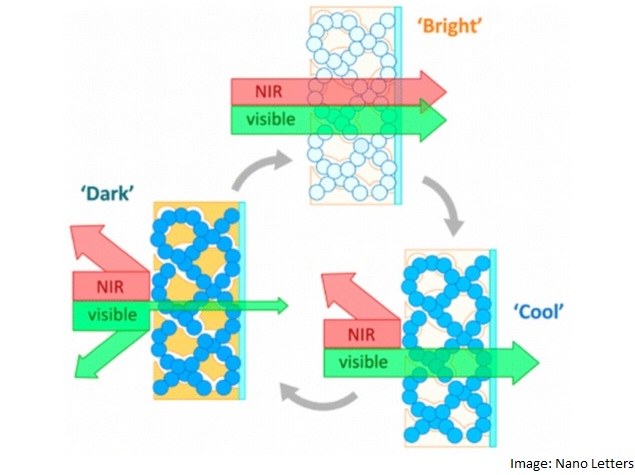- Home
- Science
- Science News
- Soon, Smart Windows to Control Heat and Light
Soon, Smart Windows to Control Heat and Light

New materials have been engineered that let windows to allow light without transferring heat and, conversely, to block light while allowing heat transmission, researchers said.
In 2013, Delia Milliron, professor at the Cockrell School of Engineering at The University of Texas, and her team became the first to develop electrochromic materials that blend two materials for selective control of visible and heat-producing near-infrared light (NIR).
The research group demonstrated how, using a small jolt of electricity, a nanocrystal material could be switched back and forth, enabling independent control of light and energy. The team now has engineered two new advancements in electrochromic materials - a highly selective cool mode and a warm mode - not thought possible several years ago. The cool mode material is a major step towards a commercialised product because it enables control of 90 per cent of NIR and 80 per cent of the visible light from the Sun and takes only minutes to switch between modes.
Milliron and the team, including Cockrell School of Engineering researcher Jongwook Kim and collaborator Brett Helms of the Lawrence Berkeley National Lab, developed a new nanostructured architecture for electrochromic materials that allows for a cool mode to block NIR light while allowing the visible light to shine through.
This could help reduce energy costs for cooling buildings and homes during the summer, researchers wrote in the study published in the journal Nano Letters.
"We believe our new architected nanocomposite could be seen as a model material, establishing the ideal design for a dual-band electrochromic material," Milliron said. "This material could be ideal for application as a smart electrochromic window for buildings," she said.
In a second study, Milliron and her team, including Cockrell School graduate student Clayton Dahlman, have showed how they can achieve optical control properties in windows from a well-crafted, single-component film.
The concept includes a simple coating that creates a new warm mode, in which visible light can be blocked, while near-infrared light can enter. This setting could be useful on a sunny winter day, when one would want infrared radiation to pass into a building for warmth, but the glare from sunlight to be reduced.
In this study, published in the Journal of the American Chemical Society, Milliron showed that a coating containing a single component - doped titania nanocrystals - could demonstrate dynamic control over the transmittance of solar radiation.
Because of two distinct charging mechanisms found at different applied voltages, this material can selectively block visible or infrared radiation.
Catch the latest from the Consumer Electronics Show on Gadgets 360, at our CES 2026 hub.
Related Stories
- Samsung Galaxy Unpacked 2025
- ChatGPT
- Redmi Note 14 Pro+
- iPhone 16
- Apple Vision Pro
- Oneplus 12
- OnePlus Nord CE 3 Lite 5G
- iPhone 13
- Xiaomi 14 Pro
- Oppo Find N3
- Tecno Spark Go (2023)
- Realme V30
- Best Phones Under 25000
- Samsung Galaxy S24 Series
- Cryptocurrency
- iQoo 12
- Samsung Galaxy S24 Ultra
- Giottus
- Samsung Galaxy Z Flip 5
- Apple 'Scary Fast'
- Housefull 5
- GoPro Hero 12 Black Review
- Invincible Season 2
- JioGlass
- HD Ready TV
- Laptop Under 50000
- Smartwatch Under 10000
- Latest Mobile Phones
- Compare Phones
- OPPO Reno 15 Pro Max
- Honor Win RT
- Honor Win
- Xiaomi 17 Ultra Leica Edition
- Xiaomi 17 Ultra
- Huawei Nova 15
- Huawei Nova 15 Pro
- Huawei Nova 15 Ultra
- Asus ProArt P16
- MacBook Pro 14-inch (M5, 2025)
- OPPO Pad Air 5
- Huawei MatePad 11.5 (2026)
- Xiaomi Watch 5
- Huawei Watch 10th Anniversary Edition
- Acerpure Nitro Z Series 100-inch QLED TV
- Samsung 43 Inch LED Ultra HD (4K) Smart TV (UA43UE81AFULXL)
- Asus ROG Ally
- Nintendo Switch Lite
- Haier 1.6 Ton 5 Star Inverter Split AC (HSU19G-MZAID5BN-INV)
- Haier 1.6 Ton 5 Star Inverter Split AC (HSU19G-MZAIM5BN-INV)
















